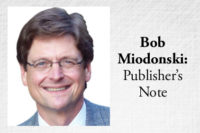
Rainwater is one of the cleanest sources of water that building occupants can use for nonpotable and even potable purposes. Its hardness and sodium content add up to zero, essentially. It contains, on average, 2 to 20 parts per million of total dissolved solids, compared to municipal water supplies, which contain 100 to 800 ppm TDS.
As soon as rainwater is captured and stored, however, it is no longer clean. Rodents and birds can leave droppings or urinate on the roof or in the rainwater catchment system. Building materials can contain animal feces, urine or saliva that wash into the system’s storage tank. Serious diseases can result from these conditions.
Clearly, an effective catchment system demands an engineering solution if building occupants are going to use the rainwater. This need for engineering helped to drive a big turnout at the rainwater reclamation session Oct. 28 during the2011 ASPE Technical Symposiumin Orlando.
Mark Girgenti, the lead sales and design engineer for environmental process design firm Burt Process Equipment, presented the three-hour seminar. He began by giving basic facts about rainwater and his material grew increasingly technical as the session progressed.
I had traveled to Florida to learn more about the topics presented in the technical sessions but also to visit with vendors, ASPE members and staff during the product show Oct. 27. In large part, I wanted to find out about the Technical Symposium, which is an event I had not attended previously.
ASPE produces its Engineered Plumbing Expo every other year, and I go to it on a regular basis. The Technical Symposium is ASPE’s off-year event.
Maybe its name threw me off. Not having a technical background myself, I had figured I would have little to gain from attending the Technical Symposium’s educational sessions.
That turned out not to be the case in Girgenti’s session or in a second one I attended on solar water heating, which was presented byChristopher Wisinskiwith the manufacturers rep firm Bornquist Inc. Even professional engineers could learn from the material in areas such as sustainable design, which may have been new to them.
As if to make that point, other sessions were titled “Plumbing 101,” presented byPeter Kraut, P.E., and “Gizmos and Doo-dads,” presented bypmecolumnist and former ASPE PresidentJulius Ballanco, P.E.
One nontechnical aspect covered in the rainwater session is the legislation that governs its capture and reuse. Girgenti said numerous states have adapted their own guidelines for rainwater systems: Hawaii, Florida, Oregon, Texas, Virginia, California, Georgia, Arizona and New Mexico.
No national standard exists for rainwater systems, he noted, adding that laws in some Western states have created the biggest impediment to a national rainwater harvesting guideline. That’s due to the doctrine of prior appropriation, which is a system of allocating water rights in these states. This doctrine has created ambiguity about the legality of capturing and storing rainwater, Girgenti said.
Given the importance of engineering in designing safe rainwater systems, I was glad to see so many ASPE members learning about them during the session in Orlando. Engineers also will need to take the next step to get involved in laws, codes and guidelines that regulate these systems.

